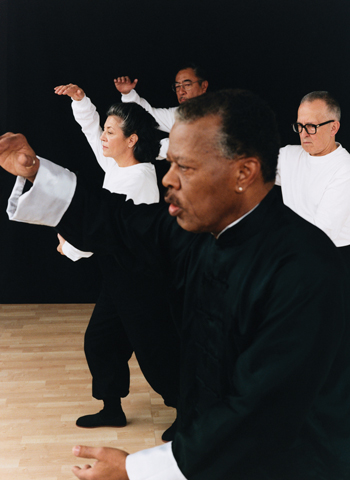‘New narrative’ for back pain means managing modalities
New modalities to treat low back pain can include alternative treatments like mindfulness meditation, acupuncture, mindful stress reduction, tai chi, yoga, and cognitive behavioral therapy.
With alternative treatments gaining ground for back pain, physicians may need to consider new types of comanagement and new definitions of treatment success, experts say.
ACP released a clinical practice guideline in 2017 that recommended nonpharmacologic treatments as the initial mode of therapy for patients with acute, subacute, or chronic low back pain. Depending on the injury, the guideline recommended nonpharmacologic treatments ranging from superficial heat, massage, and acupuncture to exercise, mindfulness-based stress reduction, tai chi, and yoga.

“These alternative treatments are therapies that are beyond what we conventionally think about in Western medicine,” said Allen S. Chen, MD, MPH, director of physiatry for the Och Spine Hospital at Columbia/New York Presbyterian in New York City. “Primary care physicians are becoming more aware of these treatments and are beginning to understand that these methods can potentially be beneficial for patients with back pain.”
Alternatives
Physicians trained to treat acute or chronic lower back pain have a good understanding of the anatomy of these injuries and are often very willing to incorporate the use of alternative therapies, according to Adrian Popescu, MD, assistant professor of clinical physical medicine and rehabilitation at University of Pennsylvania Perelman School of Medicine in Philadelphia.
“Looking at alternative therapies, I think every patient should begin with a strong educational package involving changing ergonomics, lifestyle changes, and doing a certain amount of exercise and physical therapy every day,” Dr. Popescu said.
In addition, Dr. Popescu said alternative treatments like mindfulness meditation, acupuncture, mindful stress reduction, tai chi, yoga, and cognitive behavioral therapy can all play a huge role in the management of chronic lower back pain. However, he noted that he rarely makes referrals for chiropractic care or for alternative therapies that include herbal or homeopathic medicine.
According to Dr. Chen, one of the crucial roles of the primary care physician is setting expectations about the risks and benefits of alternative therapies and explaining that not every therapy will work for every patient. In addition, although studies have looked at the efficacy of some of these therapies, no one type has been shown to be superior to any other, Dr. Chen said.
For example, a recent study published in Annals of Internal Medicine compared the use of yoga, physical therapy, or educational materials to treat chronic lower back pain in 320 low-income adults. Although the study showed that yoga was noninferior to physical therapy, it also showed that neither yoga nor physical therapy was superior to the educational control group.
Good practitioners
Physicians who work within an integrated health care system can often look within their own walls for a recommended alternative therapy practitioner.
“Within my VA hospital, I can directly refer people to the mind and body group for services like tai chi or acupuncture,” said Stefan G. Kertesz, MD, MSc, ACP Member, professor in the division of preventive medicine at the University of Alabama School of Medicine and physician with the Birmingham VA Medical Center.
However, if physicians or patients are looking more on the “open market” for practitioners, the search can be more challenging, Dr. Kertesz said.
Dr. Chen agreed. “I recommend that every patient make sure that the practitioner they are seeing has at least the minimum credentials or licensing required for the service they are providing,” he said.
J. Michael Menke, DC, PhD, associate director of research at A.T. Still Research Institute in Mesa, Ariz., pointed out that alternative medicine practices can vary widely. “So much variability exists ... that a patient could not possibly pick through the many therapists and treatments to find the most effective ones,” he said. “For instance, there are at least 200 very different types of chiropractic treatment.”
Physicians can also turn to their own social or professional contacts, or recommendations from patients who have had positive results, for reliable alternative therapy practitioners. But while recommendations help, Dr. Menke noted that common sense should ultimately rule. For instance, if acute back pain hasn't improved after eight weeks of treatment, common sense suggests re-examination and a new treatment plan, he said.
Dr. Menke also cautioned against using practitioners who make implausible claims. He said he has seen some alternative medicine clinics selling 15-minute tests and treatments to relieve conditions ranging from multiple sclerosis to Parkinson's disease.
According to his own research, “the best ‘cure’ for back pain is exercise monitored and encouraged by a trusted authority reassuring patients that their pain is not lethal,” Dr. Menke said. “Quite frankly, every alternative and medical treatment capitalizes on psychosocial support to some extent. So, getting a patient to move and re-engage in life is a win, especially when drugs and surgery can be avoided.”
Finally, avoid any practitioner who rejects science and medicine, Dr. Menke warned. He believes alternative therapies work best when integrated with medical monitoring and follow-up. The best practitioners maintain clear and frequent communication with physicians, he said.
Communication
“The internist is the quarterback for the patient with lower back pain, and they have to look for the best possible outcome for their patients,” Dr. Popescu said.
A key part of achieving those outcomes requires monitoring or follow-up after a patient has started with alternative treatments.
According to Dr. Popescu, despite the growing use of electronic medical records and technology, there is still suboptimal communication between alternative medicine providers and office-based physicians or practices.
“There are times when practitioners of some of these alternative treatments will make phone calls to the treating physician or provide brief summaries of what has happened for the patient to bring back to the physician,” Dr. Popescu said. “For the most part, though, the information about the success or lack of success is gained most thoroughly and directly with contact with the patient.”
To determine whether his patients are making progress using alternative therapies, Dr. Kertesz often uses the standardized PEG (Pain, Enjoyment, General activity) Pain Screening Tool, a three-item questionnaire that assesses pain intensity and interference by asking patients to answer three questions ranking pain on a scale from 0 to 10. PEG scores are best used to track an individual's changes over time, he noted.
“But getting this number alone is not enough,” Dr. Kertesz said. “I also ask people about their aspirations in life and how well their current activities align with those aspirations. These two things combined allow me to figure out if someone is making progress with their pain.”
Keeping an open mind
Not all physicians support the use of alternative therapies for the treatment of pain. Dr. Kertesz said that when either he or a patient has reservations about any plan for pain, including one that incorporates alternative therapies, he attempts to learn that patient's story from the beginning.
“Sometimes when we dig, we find out that pain got worse during periods of emotional suffering, or as a result of ill-advised treatments from prior caregivers,” Dr. Kertesz said. “I then pitch that story back to the patient and underscore my desire to find a path that allows him or her to pursue activities that enhance recovery. That often does not mean freedom from pain, but a path toward activity increasing.”
Dr. Kertesz said he keeps an open mind and does not take any treatment that might benefit the patient off the table, including alternative therapies, over-the-counter medications, or pharmacologic therapies, including opioids. However, he also noted that while it is appropriate for physicians to suggest alternatives to standard medications and therapies, they must also communicate to patients that only a minority will benefit from any single intervention and that benefit shown in trials is often moderate or small.
“Long-term chronic pain causes immense suffering, and we physicians are terribly trained to treat it,” Dr. Kertesz said. “We have to go beyond asking what is the best thing to do for pain, but instead we have to develop a new narrative that we can use to help our patients work through options and come up with a way for them to survive it.”





